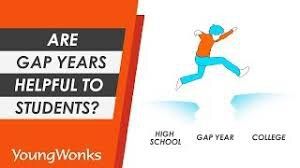Gap Year: Transform Your Life—Myths & Benefits

Every gap-year student will surely relate to these lines. Taking a gap year is a decision that can significantly impact your personal growth, education, and career trajectory.
It is seen that gap years are often taken with a negative approach in India, but people do not realize that gap years allow learners to explore their interests, goals, and aspirations beyond the classroom. So, here we are, breaking several myths and misconceptions surrounding gap years that might discourage potential gappers.
Table Of Contents:
Introduction
The concept of taking a gap year has gained popularity in recent years. Not only in urban areas, but students from rural areas are also taking drops nowadays for clearing government exams or giving entrances to their dream colleges. Traditionally, students would transition directly from high school to college or university without a break.
However, more and more young individuals are now considering the benefits of taking time off before diving into higher education or their careers. In this blog, we’ll explore why taking a gap year is not only okay but can also be a transformative experience.
What Is a Gap Year?
A gap year, often referred to as a “bridge year,” is a deliberate break from formal education or work. It typically involves taking time off between completing high school and starting college or university. Gap years provide opportunities for personal growth, self-discovery, and skill development. They allow learners to explore their interests, goals, and aspirations beyond the classroom.
Whether you’re seeking adventure, cultural immersion, or a break from academic pressure, a gap year can be a valuable and transformative experience. However, gap years can also be taken at other points in life, such as after college graduation, during a career transition or even after retirement.
Types Of Gap Year
Traveling Gap Years:
- Many people choose to spend their gap year traveling the world, exploring different countries and cultures.
- Whether it’s the mystique of the Far East, the exotics of Southeast Asia, the thrills of Australasia, the culture of Latin America, or the history of Europe, there’s something for everyone.
- Combining travel with language school is common. Imagine learning Spanish in Central America or Portuguese in Brazil while immersing yourself in local life.

Volunteering Gap Years:
- Volunteering projects, both at home and abroad, are a popular choice.
- Opportunities range from digging wells in rural Africa to helping in South American orphanages, building schools in Southeast Asia, or participating in local environmental initiatives.
- Volunteering programs often combine service with travel, allowing you to make a positive impact while exploring new places.
Working Gap Years:
- A gap year can also be an excellent time to gain work experience related to your future career path.
- Internship programs exist for young people across various industries. They provide insights into specific sectors and expose you to career options you might not have considered.
- A productively spent gap year can distinguish you on your resume or CV, showing what you gained during that time.
Debunking Myths
Myth 1 : Gap years are only for students
Fact: Gap years can be taken by students, professionals, or anyone who wants to take time off from their regular activities.
Myth 2 : Gap years are expensive
Fact: Gap years can cost what you can afford, and some students work to help pay for their experience. A gap year is an investment in your personal growth and learning. It doesn’t have to be expensive; it can be a transformative and affordable experience.
You can check out the blog at Apna Adda to learn some tips about staying pocket-friendly!
Myth 3 : Gap years are a way to delay responsibility
Fact: Gap years can be an investment in academic and professional futures and can help students develop soft skills like time management and conflict resolution.
Myth 4 : Gap years are one year long
Fact: Gap years can vary in duration. They don’t have to be a full year. Whether it’s a few months or longer, a well-planned gap year can be transformative.
Myth 5 : Gap years make you forget what you've learned in school
Fact: Taking a gap year does not necessarily lead to forgetting what you’ve learned in school. In fact, gap years can enhance your overall learning experience and contribute to personal growth.
Myth 6 : Gap years are only for high school graduates
Fact: Many professionals also take time off to travel and experience cultures. Remember, a gap year is not about age; it’s about embracing life’s opportunities.
Myth 7 : Employers Frown Upon Gap Years
Fact: A well-structured gap year can enhance your resume by showcasing skills like adaptability, cultural awareness, and problem-solving. It demonstrates that you’re not afraid to take risks and seek diverse experiences.
Myth 8 : Gap Years Delay Your Education
Fact: While it’s true that a gap year postpones formal education, it doesn’t hinder your long-term academic success. In fact, many students return from their gap years more motivated and focused.
Reasons To Take A Gap Year
Self-Discovery
A gap year allows you to explore your interests, passions, and values. Whether you’re volunteering in a foreign country, working on a farm, or pursuing a creative project, you’ll learn more about yourself and what truly matters to you.
Cultural Immersion
Traveling during a gap year exposes you to different cultures, languages, and ways of life. It broadens your perspective and fosters empathy. You’ll return home with a deeper understanding of global issues and a greater appreciation for diversity.
Skill Development
Gap years provide ample opportunities to acquire new skills. Whether you’re learning a language, volunteering in a community project, or working in a professional setting, you’ll gain practical experience that can benefit your future endeavors.
Mental Health and Well-Being
Taking a break from the academic or work grind can significantly improve your mental health. It reduces burnout, stress, and anxiety. Use this time to recharge, reflect, and prioritize self-care.
How To Plan An Effective Gap Year

Planning an effective gap year involves thoughtful consideration and strategic steps. Whether you’re a student, professional, or retiree, here are some key strategies to plan a fulfilling gap year:
Define Your Goals
- Reflect on what you want to achieve during your gap year. Consider personal interests, growth objectives, and desired experiences.
- Craft your gap year to align with your unique aspirations and needs.
Research Your Options
- Explore various gap-year opportunities. Look into programs, travel destinations, volunteer work, internships, or skill-building experiences.
- Compare program websites, read alumni reviews, and attend webinars to gather information.
Create a Budget
- Outline your budget early in the planning process. Consider costs related to travel, accommodation, activities, and other expenses.
- Having a clear budget allows you to plan, earn, and save effectively.
Plan Your Itinerary
- Decide on the duration of your gap year. Will it be a few months or a full year?
- Map out your itinerary, including destinations, activities, and timelines.
Make the Most of Your Gap Year
- Embrace new experiences, cultures, and challenges. Be open-minded and adaptable.
- Use your gap year to learn, grow, and explore beyond your comfort zone.
Plan Your Return
- Consider how your gap year will transition back into your regular life. Think about future goals, studies, or career plans.
- Highlight the skills and experiences gained during your gap year on your resume.
Conclusion
In summary, taking a gap year is a valuable experience that transcends age. It enhances learning, doesn’t harm your resume, and offers personal growth opportunities. Remember, it’s about more than just a break—it’s a chance to explore, learn, and discover.
For more interesting and exciting updates about your college and upcoming fests, stay tuned to Apna Adda!

